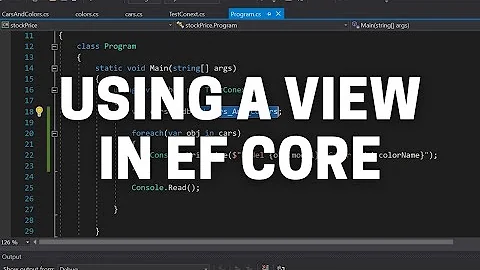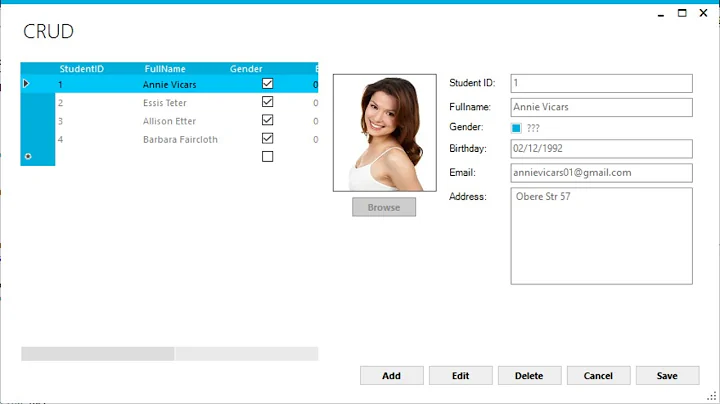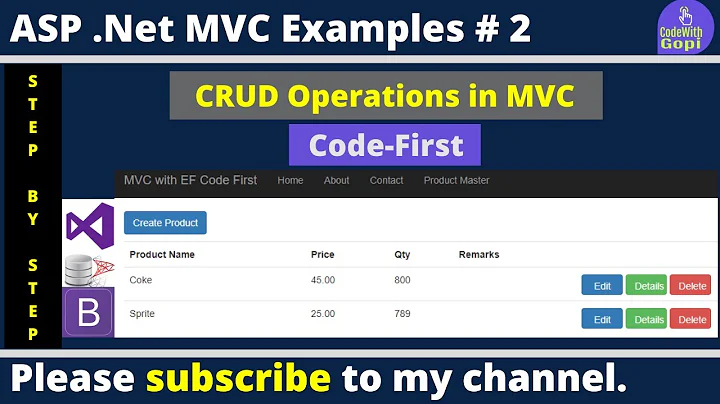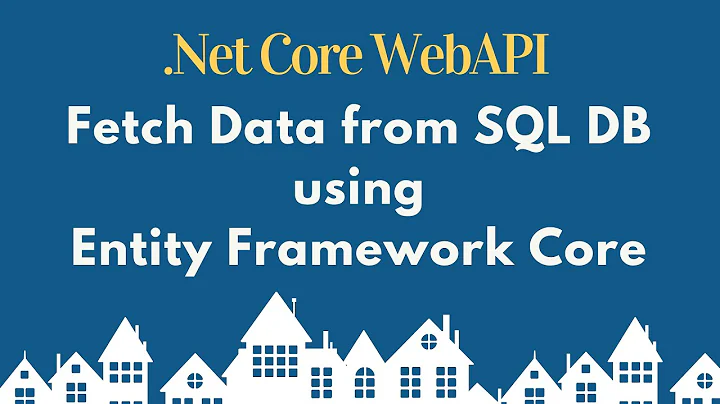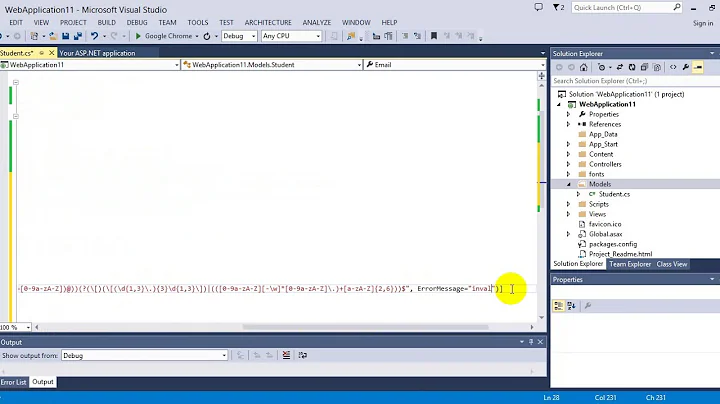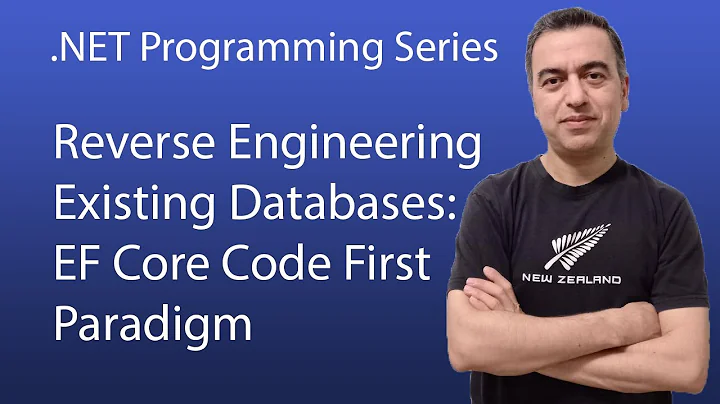How to create a view using EF code-first POCO
Solution 1
You cannot create views with EF Code First approach. If you want to create view then execute creation sql script in Seed method. But you'll still not be able to map entity to this view, except hacking model by creating and droping table with same name as your view will have.
Some helpful links:
- How map objects to a view with EF 4 code first?
- How do I define a database view using Entity Framework 4 Code-First?
Solution 2
you must manually create the view, just like AnatoliiG stated. (Adding index to a table).
You add the name of the view as an attribute to your class
[Table("UserDTO")]
public class UserDTO
{
/* Class code here */
}
You can create an empty migration by specifying the -IgnoreChanges attribute at the end
Add-Migration MigrationName -IgnoreChanges
This gives you an empty migration script that you can manually modify.
You can use your db context to execute your code in your migration script
public partial class editUserDTO : DbMigration
{
public override void Up()
{
string script =
@"
CREATE VIEW dbo.UserDTO
AS SELECT p.PersonId AS UserId, p.FirstName, p.LastName, u.UserName
FROM dbo.Users u
INNER JOIN dbo.People p ON u.PersonId = p.PersonId";
BloggingContext ctx = new BloggingContext();
ctx.Database.ExecuteSqlCommand(script);
}
public override void Down()
{
BloggingContext ctx = new BloggingContext();
ctx.Database.ExecuteSqlCommand("DROP VIEW dbo.UserDTO");
}
}
Solution 3
Just a heads up, in EF 6.1 (not sure if in earlier or not) there is now a Code First from Database option you can use and it will map to views as well.
I personally have mine in a separate junk project so I can just take out the code I want from it and not impact my project that actually uses the database. To use it Add a New file to your project -> Data -> ADO.NET Entity Data Model
Then select the Code First From Database option and select your views (and other tables if you want)
It will create it as a Table mapping like Fred was talking about in his answer, but will do all the code for you which is nice. You'll probably want to change the indexes and ordering though.
Then just call Sql(@"YOUR VIEW CREATE SQL HERE") in your Up and add a Sql(@"DROP STATEMENT HERE") in your Down
Solution 4
A lot of good insights from the official issues thread of EF7:
1) Don't have a DbSet, and instead have a property or extension method
A) Property
class YourContext
{
public IQueryable<YourView> YourView
{
get
{
return this.Database.SqlQuery<YourView>("select * from dbo.YourView");
}
}
}
B) Extension Method
static class YourContextExtensions
{
public static IQueryable<YourView>(this YourContext context)
{
return context.Database.SqlQuery<YourView>("select * from dbo.YourView");
}
2) Apparently, you can have the migration process ignore certain dbsets
protected override void OnModelCreating(ModelBuilder modelBuilder)
{
if (IsMigration)
modelBuilder.Ignore<YourViewTable>();
...
}
(All the above are untested)
Related videos on Youtube
Chuck Norris
Updated on July 09, 2022Comments
-
Chuck Norris almost 2 years
That simple. I need to create a View using Code First. I found nothing about this on google nor SO. Is there a way to accomplish this?
I need that view to be created and queried using linq, so it's not a solution to create it using an script on Database creation, for example:
var results = from c in db.Customer join v in db.MyView on c.Id equals v.Id select c;A work around is also acceptable. I need a way to query entities against non-constant/ non-entities values.
-
Chuck Norris over 11 yearscreate a view: create an sql view, just like you code an entity and it's translated as a Table on SQL.
-
-
Stafford Williams over 8 yearsShouldn't the
CREATEonly should be inUp()and theDROPonly be in theDown()? -
Fred almost 8 yearshi there... Attempted to correct the code I wrote in this post, (removed ctx.Database.ExecuteSqlCommand(script); from the "Down" method) but was rejected by 3 users.
-
Monojit Sarkar over 7 yearshow to map my existing sql server to EF code first ? looking for good example. thanks
-
Jim Kiely over 7 yearsI did this and I get an error "Unable to update database to match the current model because there are pending changes and automatic migration is disabled." How do you resolve this?
-
 Kind Contributor about 7 yearsThis was an unimaginative answer. Workarounds were probably possible back in 2012. Make sure you look at the other answers.
Kind Contributor about 7 yearsThis was an unimaginative answer. Workarounds were probably possible back in 2012. Make sure you look at the other answers. -
 Max about 7 yearsA point doesn't work
Max about 7 yearsA point doesn't workCannot implicitly convert type 'Syste.Data.Entity.Infrastructure.DbRawSqlQuery .. to ...<model>you must change IQueryable to IEnumerable -
 Kind Contributor about 7 yearsTack, asqueryable to the end after sqlquery function
Kind Contributor about 7 yearsTack, asqueryable to the end after sqlquery function -
 Ortund almost 7 yearsHi! Please revise your answer as it doesn't actually answer the OP's question but instead just indicates that what the OP wants to do can't be done. If you need help, check out how to answer in the help section.
Ortund almost 7 yearsHi! Please revise your answer as it doesn't actually answer the OP's question but instead just indicates that what the OP wants to do can't be done. If you need help, check out how to answer in the help section. -
Rudey almost 7 yearsInstead of creating a context and calling
ctx.Database.ExecuteSqlCommand, you can just use theSql(...)function inherited fromDbMigration. -
Rudey almost 7 yearsWon't the changes ignored by
-IgnoreChangesshow up in the next added migration? -
Rudey almost 7 yearsI don't think this belongs in the seed method. Creating a view should be done in an EF migration.
-
Rudey almost 7 yearsNo, don't chain
AsQueryableafterSqlQuery. That won't provide you with a dynamic query object. When usingSqlQueryas suggested, all records will be selected and loaded into memory, even though the code filters them with aWhereor usesFirstOrDefault... See this answer. -
Sebas over 6 yearsSolution number 2 tested and working here. I have used stackoverflow.com/a/31102959/1291428 as an inspiration for setting the isMigration flag.
-
 Natalie Perret over 6 years@Todd B cannot compile, where did you manage to get "this" in a static class without being in the method signature? =]
Natalie Perret over 6 years@Todd B cannot compile, where did you manage to get "this" in a static class without being in the method signature? =] -
 Kind Contributor over 6 years@Ethouarn fixed
Kind Contributor over 6 years@Ethouarn fixed -
uonchiu over 6 yearsMaybe missings steps, but I had to add Dbset of the new view class to the DbContext before the "Add-Migration" step. Also, after editing the empty migration script to implement the add and drop of the view, I had to drop the view manually and the run "Update-Database" to make sure I didn't make a mistake in the script and to complete the migration/database-update pair.
-
Heretic Monkey over 5 yearsThis answer is the same as this one from four years previous.
-
Barry over 4 yearsSqlGenerator w/ Table Annotations anyone? strange answer.
-
Richard Barraclough over 4 yearsWhat is "the seed method"?

